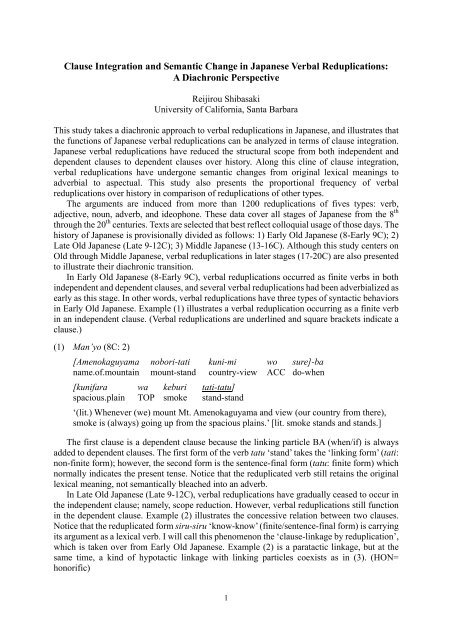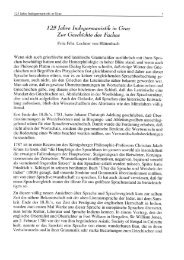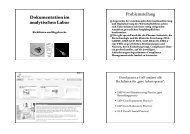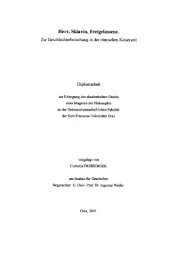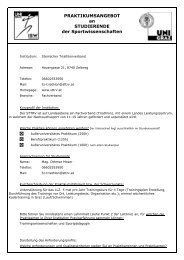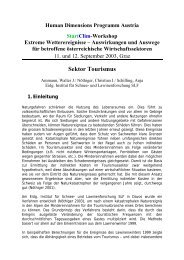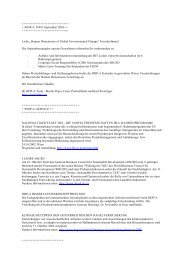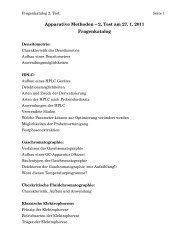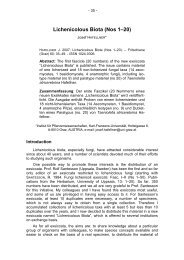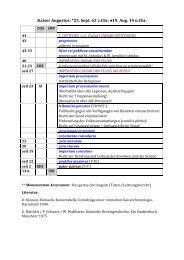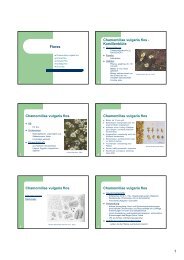A Diachronic Perspective
A Diachronic Perspective
A Diachronic Perspective
Create successful ePaper yourself
Turn your PDF publications into a flip-book with our unique Google optimized e-Paper software.
Clause Integration and Semantic Change in Japanese Verbal Reduplications:<br />
A <strong>Diachronic</strong> <strong>Perspective</strong><br />
Reijirou Shibasaki<br />
University of California, Santa Barbara<br />
This study takes a diachronic approach to verbal reduplications in Japanese, and illustrates that<br />
the functions of Japanese verbal reduplications can be analyzed in terms of clause integration.<br />
Japanese verbal reduplications have reduced the structural scope from both independent and<br />
dependent clauses to dependent clauses over history. Along this cline of clause integration,<br />
verbal reduplications have undergone semantic changes from original lexical meanings to<br />
adverbial to aspectual. This study also presents the proportional frequency of verbal<br />
reduplications over history in comparison of reduplications of other types.<br />
The arguments are induced from more than 1200 reduplications of fives types: verb,<br />
adjective, noun, adverb, and ideophone. These data cover all stages of Japanese from the 8 th<br />
through the 20 th centuries. Texts are selected that best reflect colloquial usage of those days. The<br />
history of Japanese is provisionally divided as follows: 1) Early Old Japanese (8-Early 9C); 2)<br />
Late Old Japanese (Late 9-12C); 3) Middle Japanese (13-16C). Although this study centers on<br />
Old through Middle Japanese, verbal reduplications in later stages (17-20C) are also presented<br />
to illustrate their diachronic transition.<br />
In Early Old Japanese (8-Early 9C), verbal reduplications occurred as finite verbs in both<br />
independent and dependent clauses, and several verbal reduplications had been adverbialized as<br />
early as this stage. In other words, verbal reduplications have three types of syntactic behaviors<br />
in Early Old Japanese. Example (1) illustrates a verbal reduplication occurring as a finite verb<br />
in an independent clause. (Verbal reduplications are underlined and square brackets indicate a<br />
clause.)<br />
(1) Man’yo (8C: 2)<br />
[Amenokaguyama nobori-tati kuni-mi wo sure]-ba<br />
name.of.mountain mount-stand country-view ACC do-when<br />
[kunifara wa keburi tati-tatu]<br />
spacious.plain TOP smoke stand-stand<br />
‘(lit.) Whenever (we) mount Mt. Amenokaguyama and view (our country from there),<br />
smoke is (always) going up from the spacious plains.’ [lit. smoke stands and stands.]<br />
The first clause is a dependent clause because the linking particle BA (when/if) is always<br />
added to dependent clauses. The first form of the verb tatu ‘stand’ takes the ‘linking form’ (tati:<br />
non-finite form); however, the second form is the sentence-final form (tatu: finite form) which<br />
normally indicates the present tense. Notice that the reduplicated verb still retains the original<br />
lexical meaning, not semantically bleached into an adverb.<br />
In Late Old Japanese (Late 9-12C), verbal reduplications have gradually ceased to occur in<br />
the independent clause; namely, scope reduction. However, verbal reduplications still function<br />
in the dependent clause. Example (2) illustrates the concessive relation between two clauses.<br />
Notice that the reduplicated form siru-siru ‘know-know’ (finite/sentence-final form) is carrying<br />
its argument as a lexical verb. I will call this phenomenon the ‘clause-linkage by reduplication’,<br />
which is taken over from Early Old Japanese. Example (2) is a paratactic linkage, but at the<br />
same time, a kind of hypotactic linkage with linking particles coexists as in (3). (HON=<br />
honorific)<br />
1
(2) Heichu (10C: 465)<br />
[fito no yo no fakanaki wo siru-siru] [farukani i-namu]<br />
people GEN life GEN be.in.vain ACC know-know far go-will<br />
‘(The man i) knows the emptiness of life, but (he i) will go far away.’<br />
(3) Yamato (10C: 295)<br />
[seken no koto afarenaru ifi-ifi]-te<br />
world GEN thing sad.things say-say-and<br />
[kano otodo no yomi-tamafi-keru]<br />
that.DISTAL esquire NOM intone-HON-PERF<br />
‘(Esquire i and ladies) had talked about sad things in the world, and he i intoned (a song).’<br />
Verbal reduplications have also retained adverbial functions; however, they started to<br />
accelerate the semantic change from original lexical verbs to adverbs. In (4), the verbal<br />
reduplication is followed by the adverbial particle TO, which indicates that the semantics of this<br />
verbal reduplication is not lexical, but become adverbialized (it is impossible to ‘brandish the<br />
umbrella while creeping’). Adverbialized reduplications cannot take any linking particles<br />
unlike (3). (AP= adverbial particle; PERF=perfective)<br />
(4) Otikubo (10C: 124)<br />
[kasa wo [hou-hou-to] ute-ba] kuso no ito<br />
umbrella ACC creep-creep-AP hit-because dung NOM very<br />
ookaru ufe ni kagamari wi-nu<br />
be.many on in stoop sit-PERF<br />
‘Because (the messenger) energetically brandished the umbrella, (the two men<br />
involuntarily) turned over on the dirty place.’<br />
Syntactic<br />
Level<br />
Independent<br />
Clause Verbs<br />
Dependent<br />
Clause Verbs<br />
Table 1: <strong>Diachronic</strong> Syntax-Semantics Change in Verbal Reduplications<br />
8-Early 9C Late 9-12C 13-16C 17-20C<br />
OK<br />
[finite V]<br />
OK<br />
[non-finite V]<br />
OK<br />
[adverbial]<br />
OK (rare)<br />
[finite V]<br />
OK<br />
[non-finite V]<br />
OK<br />
[adverbial]<br />
[aspectual]<br />
almost<br />
none<br />
OK (rare)<br />
[non-finite V]<br />
OK<br />
[adverbial]<br />
[aspectual]<br />
almost<br />
none<br />
OK (rare)<br />
[aspectual]<br />
Semantic<br />
Level<br />
Original Lexical<br />
Meaning<br />
Adverbialized<br />
Meaning<br />
In this case, the reduplicated form creates the new meaning ‘energetically’ through the<br />
phonological change and reduction (fou < fafu ‘creep’ [v.t.]) to modify the verb ute ‘hit’ (< utu).<br />
Notice that the verbal reduplication cannot take any arguments and are integrated into the<br />
independent clause: valency-decreasing. I will call this ‘clause-integration’. From Middle<br />
Japanese (13-16C) through the 20 th century, verbal reduplications have decreased in number<br />
2
and have totally been adverbialized or aspectualized in meaning as in Table 1. Chart 1 shows the<br />
diachronic proportional frequencies of Japanese verbal reduplications. (At the conference,<br />
types and tokens of verbal reduplications are to be illustrated.)<br />
Chart 1: <strong>Diachronic</strong> Proportional Frequencies of Verbal Reduplications<br />
35.00%<br />
30.00%<br />
25.00%<br />
20.00%<br />
15.00%<br />
10.00%<br />
5.00%<br />
0.00%<br />
8C<br />
9-10C<br />
11-12C<br />
13-14C<br />
15-16C<br />
18C<br />
20C<br />
V- Redup<br />
Verbal reduplications have paradigmatically changed over history. In Early Old Japanese<br />
(8-Early 9C), they could function as finite verbs in independent clauses as in (1). From Late Old<br />
Japanese (Late 9-12C) on, they have gradually reduced its structural scope into dependent<br />
clauses in order to modify the independent clause: clause-linkage by reduplication, as in (2).<br />
Clause integration has further proceeded. Because of the decline of clause-linking properties in<br />
verbs, the clause-linking function of verbal reduplication has been taken over to other linking<br />
particles from Middle Japanese (13-16C) on. At the same time, verbal reduplications have<br />
undergone semantic changes: original lexical > adverbial > aspectual, and adverbialized<br />
reduplications have been dominant from Late Old Japanese to the present. This indicates that<br />
verbal reduplications have been adverbialized to modify the finite verb in the independent<br />
clause: clause-integration, as in (4). Through this clause integration, Japanese verbal<br />
reduplications have a growing tendency to appear pre-verbally in the basic SOV construction<br />
(74% on average) as in (4).<br />
Although recent historical-typological studies on grammaticalization reveal that structural<br />
scope expands rather than reduces, Japanese verbal reduplications support well-attested<br />
patterns of the grammaticalization of clause-linkage along a “unidirectional cline from<br />
relatively free juxtaposition to syntactic and morphological bondedness” (Hopper and Traugott<br />
1993: 168). The diachronic process of lexical items (verbs, in this case) into adverbs also<br />
follows a general principle of weakening or decategorization. Furthermore, the gradual but<br />
steady decline of Japanese verbal reduplications as observed in Chart 1 reminds us of the<br />
classical view of grammaticalization (Givón 1979: 209): discourse > syntax > morphology ><br />
morphophonemics > zero. Of course, it is conceivable that there may be variations according to<br />
dialects and idiolects. But the findings as illustrated in Table 1 and Figure 1 cannot be an<br />
accident. Therefore, it can be concluded that Japanese verbal reduplications have reduced their<br />
structural scopes over history: 1) independent > dependent clauses; 2) finite verbs > non-finite<br />
verbs > adverb > aspectual; 3) more > less frequency.<br />
3


